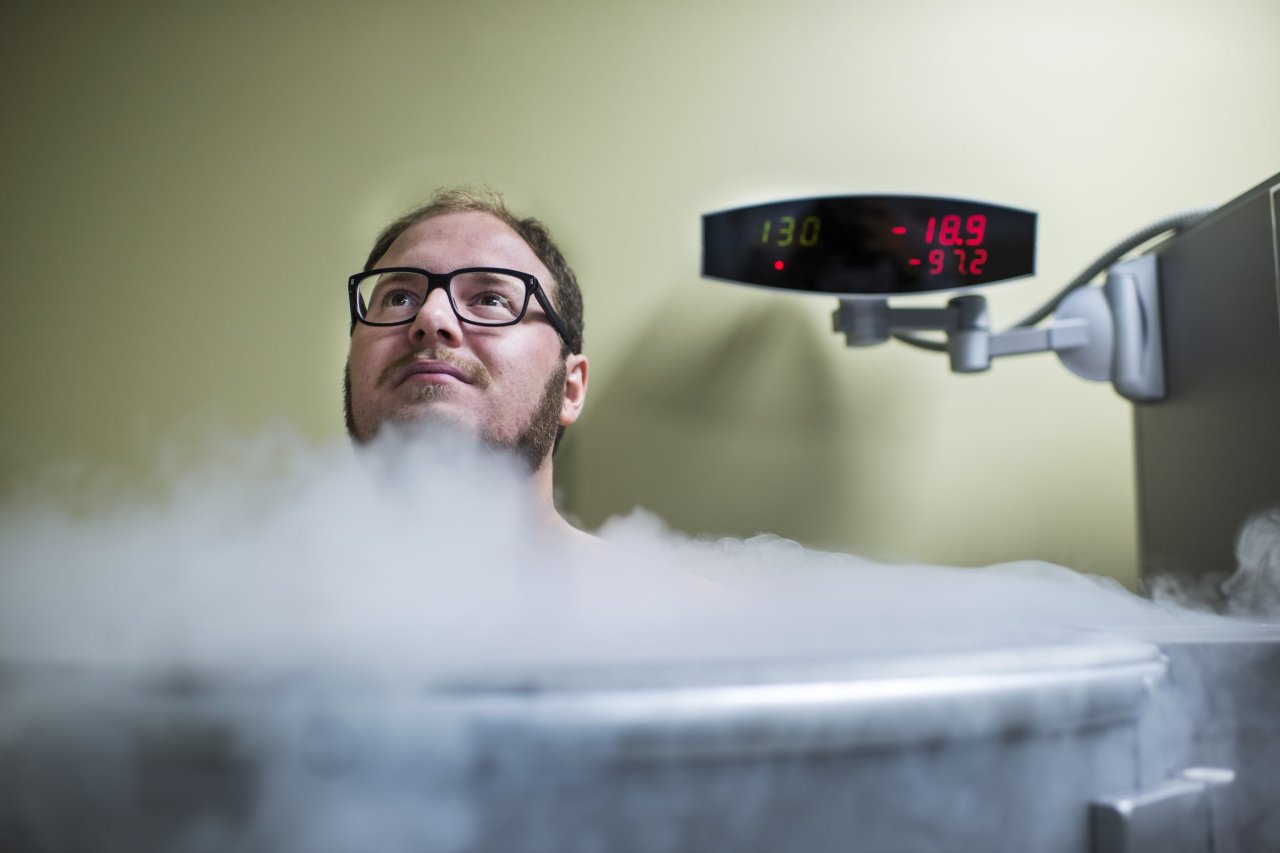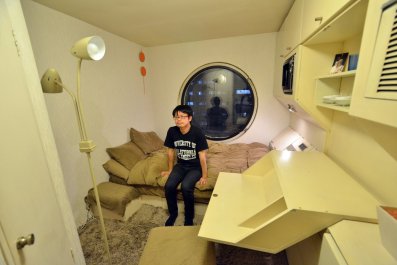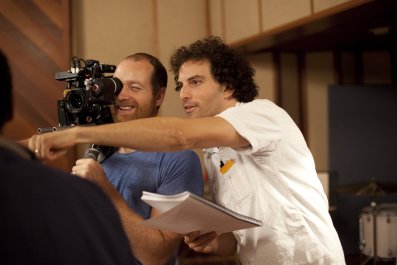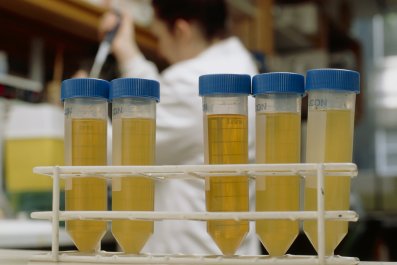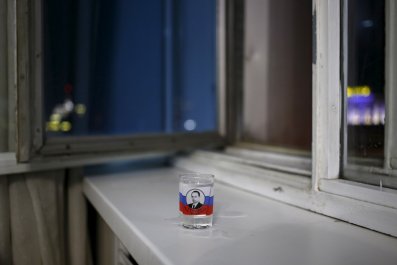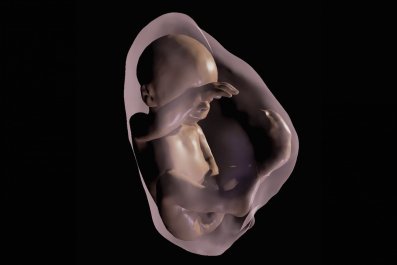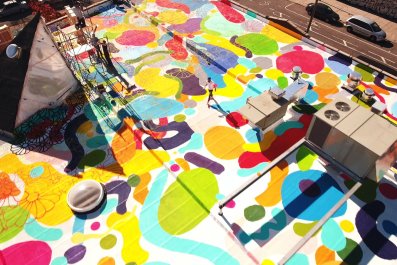Updated | For years, Kyle Patten, a former college baseball player and competitive powerlifter, recovered from intense workouts with toe-curling ice baths. He'd put on a pair of socks and fill his bathtub with ice, and he was like the olive in a huge gin and tonic. Patten would settle into his deep freeze for at least a half-hour, but that alleviated only the discomfort in his legs, and it was often an intolerable soak. These days, he sticks to golf, but the pain from old injuries hasn't gone away.
He first learned about whole body cryotherapy from a friend, who swore that just three to four minutes in the Space Age–looking apparatus, known as a cryosauna, could produce the same results as his icy tub-athons. Patten tried it and was sold. "It takes a couple of sessions, but once you get in the groove it feels incredible," he says.
Scores of professional athletes (like LeBron James, Kobe Bryant and David Beckham), celebrities (Jessica Alba, Alicia Keys and Mandy Moore) and an increasing number of physicians and other medical practitioners have touted the benefits of cryo treatment, but these claims are backed only by personal anecdotes and a smattering of obscure studies that critics say are poorly designed and lack statistical significance. And the Food and Drug Administration (FDA) is also chilly to the concept: It warns that cryotherapy can cause asphyxiation, frostbite, severe burns and injury to eyes. It's also possible for a person to lose consciousness, because the nitrogen vapors in a closed room can result in oxygen deficiency. Oh, and whole body cryotherapy might cause a heart attack in a person with cardiac disease.
The unregulated devices also pose the potential for misuse. Last year, a woman who worked at a spa in Las Vegas tried out the system after hours and accidentally locked herself in the contraption. She passed out and died of suffocation. When her colleagues showed up the next day, she was frozen stiff.
The FDA regulates any product that meets the definition of a medical device "intended for use in the diagnosis of disease or other conditions, or in the cure, mitigation, treatment, or prevention of disease." A company that doesn't plan to market and sell a device intended for medical purposes doesn't require FDA clearance. An increasing number of cryosauna companies claim to treat or cure serious medical conditions such as Alzheimer's disease, asthma, migraines and depression. Some advertise that the therapy can promote weight loss or slow aging. When they make medical claims, the FDA may take action to bring them into compliance with the law.
In August, the FDA sent letters to two cryosauna companies making medical claims, America Cryo USA and Cryohealthcare Inc. An FDA spokesperson told Newsweek the agency is "concerned about device labeling that may be false or misleading to consumers, including claims made on websites."
Not a Warm, Fuzzy Feeling
A session in a cryosauna involves stepping into the freezing chamber cooled with liquid nitrogen vapor to around minus-250 degrees Fahrenheit or lower. The user wears only gloves, socks and underwear to protect the most cold-sensitive areas of the body. Some chambers run a little warmer, and some resemble fancy walk-in refrigerators, with seating for more than one. But the premise is the same: Send the body into "fight or flight" mode by subjecting it to extreme cold, and get plenty of oxygen-rich blood flowing to the body's core. That blood then returns to the extremities and is said to speed the body's healing process and reduce inflammation.
Lance Mald, chief marketing officer and co-founder of KryoGenesis, says his is the first company in the U.S. to have a cryosauna in a doctor's office. That doctor, Kenneth McCulloch, a top-rated orthopedic surgeon in New York City, says his goal is to make the therapy more accessible to patients. In the past, McCulloch has offered other unregulated therapies, including stem cell injections or platelet-rich plasma injections. " There's a lot of things that were delayed in obtaining FDA approval that were used for years, and literally decades, in Europe and Asia before the United States," he says.
Whole body cryotherapy was developed in the 1970s by a Japanese physician to treat rheumatoid arthritis patients. It soon became wildly popular in Europe, where it is often covered by health insurance. Its popularity began taking off in the U.S. a little more than a decade ago.
The benefits of applying cold to an injured body part, even a bag of ice, are disputed by many health experts. For every physician who claims cold therapy soothes injury and speeds healing, there are experts who say introducing cold to the skin delays healing. A study published in The American Journal of Sports Medicine in 2013 found that while cold on the skin slowed swelling, it did not speed up recovery of muscle damage. A study published in 2014 in Knee Surgery Sports Traumatology, Arthroscopy suggests that icing slows the body's natural healing process by constricting blood vessels long after the compress is removed.
However, most physicians since Hippocrates have recognized that ice can help alleviate pain and inflammation. Though it's still not completely understood why, when something cold is placed on the skin—at the site of injury—some physiological changes occur: cold constricts blood vessels, which reduces blood flow to the injury and prevents fluid buildup. (Swelling from injury compresses nearby tissue, which causes pain.) Ice also numbs the surface of the skin, acting as an analgesic.
Dr. Charles Kim, a pain management specialist at NYU Langone Medical Center, says the risks of cryotherapy still seem to outweigh the benefits, especially when considering the price tag. Treatments run around $40 to $80, and cryotherapists recommend at least 10 sessions to reap the benefits of the Arctic blast. "Ice has been around for a long, long time. It does the trick. It's cheap," he says. "Sometimes ice is even too cold, so I tell my patients to get a bag of frozen vegetables."
Correction: An earlier version of this story misstated that Lance Mald is chief medical officer of KryoGenesis. He is chief marketing officer of the company.



